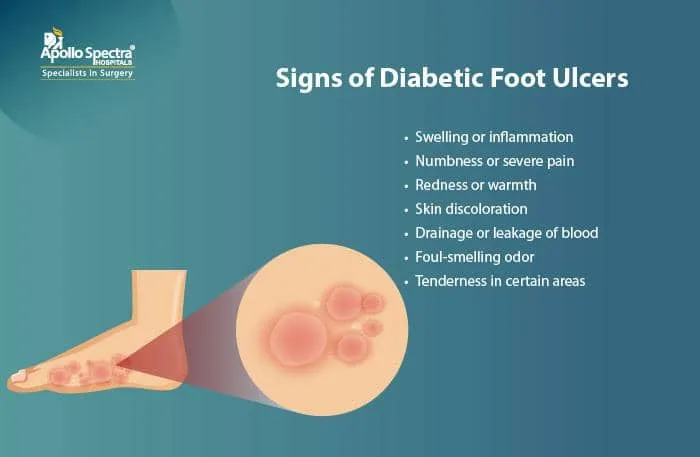Understanding Diabetic Foot Ulcers - Treatment and Preventive Care
July 3, 2023
A higher blood sugar level than normal affects your body functions. Apart from countless complications, over 25% of diabetic people in India have been struggling with diabetic foot ulcers. Even though it can be healed in the beginning stage, the concern is that the condition often heals slowly or doesn't heal, eventually threatening amputation and endangering lives if not treated on time.
Apollo Spectra Experts in Chennai are here to offer optimum care tips and treatment options to prevent health issues from reaching the extreme stage.
Understanding Diabetic Foot Ulcers - Definition and Classification
Diabetic foot ulcers are open sores or wounds on the foot's bottom (plantar surface). They appear as red, small, circular craters surrounded by callused, thick skin. The condition usually occurs when your blood sugar level is too high for a long time. It will, in turn, damage the blood vessels and nerves in the feet, thereby increasing the chances of developing foot ulcers.
Foot ulcers are classified by location, size, and the affected area in your body. However, they are also categorized depending on stages:
- Normal Feet – A normal stage where the healthcare professional recommends wearing proper-fitting footwear with an effective foot care plan.
- At-risk foot – The doctor will inspect for any evidence of limited blood flow or nerve damage due to diabetes. It will increase your risk for foot ulcers.
- Ulcer-induced feet – In this stage, it is vital to reduce the pressure on the foot by using wheelchairs or an air cast, eventually preventing any infection.
- An infected foot – The stage requires hospitalization as the open wound will have a bacterial or fungal infection which requires medication or surgery.
- Gangrene feet – At this stage, the foot will have a dead issue because of limited blood flow or inaction loss. It involves hospital admission, bed rest, and sometimes surgical intervention.
- Amputation – In this stage, the foot must be amputated due to severe damage from infection to prevent life-threatening situations.
Reasons for Diabetic Foot Ulcers
Diabetic foot ulcers can occur due to multiple reasons. Here are the top reasons:
- Elevated blood sugar level narrows down the arteries and blood vessels, limiting the blood flow and oxygen.
- Diabetic individuals usually have peripheral arterial disease that restricts blood flow to their legs and feet.
- Fluctuating blood glucose levels cause nerve damage in diabetic people. It will cause loss of pain or any other sensation in your feet.
- Diabetic people have weaker immune systems, making them easily prone to infection.
Signs and Symptoms of Diabetic foot ulcers
Here are some warning signs of diabetic foot ulcers to look out for in your foot:
- Swelling or inflammation
- Numbness or severe pain
- Redness or warmth
- Skin discoloration
- Drainage or leakage of blood
- Foul-smelling odor
- Tenderness in certain areas
Possible Treatments
Based on the diagnosis from the doctor, you may be suggested with any of the following treatment approaches.
- Medications – Healthcare professionals will prescribe antibiotics and anticloting medication to cure diabetic foot ulcers. Certain topical ointments can also be applied to treat the condition.
- Pressure off-loading – Wearing a special brace or footgear will reduce the pressure and irritation in the area. It will aid in accelerating the healing process.
- Debridement – In this approach, the infected or dead skin caused by diabetic ulcers will be cleaned using a scalpel. Then it will be washed with a disinfectant solution.
- Achilles Tendon Lengthening – The surgeon will stretch the Achilles tendon to enable the diabetic person to walk normally with better alignments and faster healing.
- Atherectomy –The clogged artery will be removed by inserting the cathartic under anesthesia.
Tips for Prevention of Diabetic Foot Ulcers
Diabetic foot ulcers are the most common reason for extended hospital stays among people. However, by following care tips, it is possible to avoid the condition
- Check your feet regularly and inspect the skin on your feet daily to look out for any bruises or swelling.
- If you have a high blood sugar level caused by diabetes, avoid walking around barefoot.
- Don’t just use any random shoes, as they will exert excess pressure on your feet, which will cause diabetic foot ulcers. Pick the right footwear size with breathable fabrics.
- Consuming a well-balanced diet packed with fiber, protein, and low saturated fats, is beneficial for diabetic people to prevent the onset of foot ulcers.
Wrapping up,
Foot ulcers are one of the severe complications of diabetes. When left untreated without proper care, it will even cost you losing your foot. However, they can be treated when the signs are caught early.
If you see any signs of diabetic foot ulcers, schedule a consultation with our Apollo Foot and Ankle Clinic in Chennai specialist to heal the infection immediately. Moreover, we also help you develop a healthy diabetes self-management plan, design a healthy diet, regular exercise, blood sugar monitoring, and daily foot care.
Foot ulcers in diabetic people happen due to poor blood circulation, easy susceptibility to infection, and nerve damage from elevated blood sugar levels.
The healing period for diabetic foot ulcers differs based on various factors. It will take a few weeks to several months to completely cure the condition properly.
Yes, diabetic foot ulcers are preventable. Regular check-ups, proper care, and timely detection can help to address them before it becomes a severe sore.
NOTICE BOARD
CONTACT US
CONTACT US
 Book Appointment
Book Appointment


.svg)
.svg)
.svg)
.svg)








